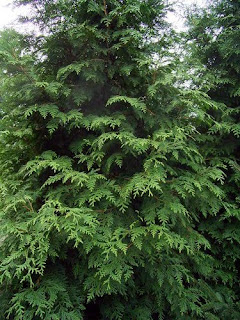The 8 Best Plants for PrivacyUse these unexpected options that can create a unique hedge or screen.
Conifers or needled evergreens create large-scale, year-round boundaries. Their glowing hues of emerald green, blue, or gold brighten the landscape, especially in winter. Conifers, in addition, exhibit strong, vertical, and often pyramidal growth habit, which gives them a unique presence. Although they seem like an odd choice for hedges or screens, they are ideal for establishing a visual boundary in the landscape.
 'Yoshino' Japanese cedarCryptomeria japonica
'Yoshino' Japanese cedarCryptomeria japonica '
Yoshino'
Type: Evergreen tree
Zone: 5 to 8
Growth Rate: fast
Height: 30-35 feet
Width: 5 feet Soil Preference: Will tolerate drought and will grow in dry soil but prefers well-drained/loamy, sandy or clay soils with a
pH of acidic to slightly alkaline
Light Requirements: Full sun
Attributes: Tolerant of many soils
 'Gowdy' Oriental sprucePicea orientalis
'Gowdy' Oriental sprucePicea orientalis '
Gowdy'
Type: Evergreen tree
Zone: 4 to 7
Growth Rate: Slow
Height: 8-10 feet
Width: 4-5 feet
Soil Preference: Clay, moist, sandy
Light Requirements: Full sun
Attributes: Intense dark green foliage,
recurved, sweeping branches
 Western red cedarThuja plicata
Western red cedarThuja plicata and
cvsType: Evergreen tree
Zone: 5 to 7
Growth Rate: Slow
Height: 50-70 feet
Width: 20 feet
Soil Preference: moist, loamy
Light Requirements: Full sun
Attributes: tolerant of somewhat wet soils, can easily be sheared
Broad-leaved evergreens make a perfect four season fence. If the size of a conifer is too big for your space, consider one a broad-leaved evergreen that stays smaller and more more compact. These plants reach a mature size quickly and flower readily, some even have berries, which give them added appeal.
 InkberryIlex glabra
InkberryIlex glabra and
cvsType: Broad-leaved evergreen shrub
Zone: 5
Growth Rate: moderate
Height: 4-8 feet
Width: 6-8 feet
Soil Preference: adequate soil moisture, acidic pH
Light Requirements: Full sun to partial shade
Attributes: tolerates wet soil, lustrous dark green glossy, black berries
 Photo by admin
Photo by admin semi-evergreen woody shrub
Zone: 6-9
Growth Rate: fast
Size: 6-8 feet, clumping spreader
Soil Preference: prefers rich, moist to average soil
Light Requirements: Full sun to shade
Attributes: tolerates dry spells once established,
panicles of bright red berries that hold on for months, Plant can become invasive in warmer climates
Deciduous shrubs create unobtrusive screens. A quality a plant needs to be an effective hedge or screen is a dense growth habit. Even in winter, when these shrubs have no foliage, their thick branching habit will create a visual barrier. If you're looking to create an informal screen or would like to use a plant that offers more than predictable green leaves, try these options, which have attractive foliage as well as interesting blooms.
 photo by Northscaping.com
photo by Northscaping.com woody shrub
Zone: 5a
Growth Rate: fast
Size: 6 foot spread
Soil Preference: moist to average soil
Light Requirements: Full sun to partial shade
Attributes: tolerant of urban pollution, red fall color, showy peeling bark for winter interest
 Cutleaf stephanandraStephanandra incisaType:
Cutleaf stephanandraStephanandra incisaType: low growing shrub
Zone: 4a
Growth Rate: fast
Size: 5 foot spread
Soil Preference: moist to average, acidic soils
Light Requirements: Full sun to partial shade
Attributes: emerald green, fine textured foliage emerging burgundy in spring, orange fall color
 Buttercup winter hazelCorylopsis paucifloraType:
Buttercup winter hazelCorylopsis paucifloraType: multi-stemmed deciduous shrub
Zone: 6a
Growth Rate: fast
Size: 6 foot tall, 8 foot spread
Soil Preference: moist to average, prefers rich soil
Light Requirements: Full sun to shade
Attributes: fragrant lemon yellow in early spring, forest green foliage turning outstanding yellow in fall, relatively low maintenance
Article by Vincent A.
Simeone from Fine Gardening, Feb 2011
www.finegardening.com








































